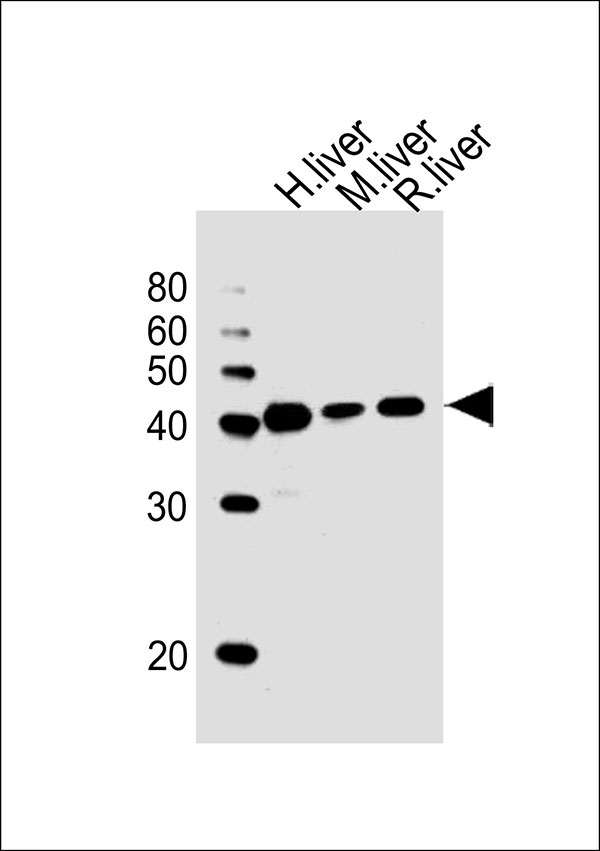HAO1 Antibody (Center)
Affinity Purified Rabbit Polyclonal Antibody (Pab)
- 产品详情
- 实验流程
- 背景知识
Application
| WB |
|---|---|
| Primary Accession | Q9UJM8 |
| Other Accession | Q9WU19 |
| Reactivity | Human, Mouse, Rat |
| Host | Rabbit |
| Clonality | Polyclonal |
| Calculated MW | 40924 Da |
| Isotype | Rabbit IgG |
| Antigen Source | HUMAN |
| Gene ID | 54363 |
|---|---|
| Antigen Region | 157-185 aa |
| Other Names | Hydroxyacid oxidase 1, HAOX1, Glycolate oxidase, GOX, HAO1, GOX1, HAOX1 |
| Dilution | WB~~1:1000 |
| Target/Specificity | This HAO1 antibody is generated from rabbits immunized with a KLH conjugated synthetic peptide between 157-185 amino acids from the Central region of human HAO1. |
| Format | Purified polyclonal antibody supplied in PBS with 0.09% (W/V) sodium azide. This antibody is purified through a protein A column, followed by peptide affinity purification. |
| Storage | Maintain refrigerated at 2-8°C for up to 2 weeks. For long term storage store at -20°C in small aliquots to prevent freeze-thaw cycles. |
| Precautions | HAO1 Antibody (Center) is for research use only and not for use in diagnostic or therapeutic procedures. |
| Name | HAO1 {ECO:0000303|PubMed:10978532, ECO:0000312|HGNC:HGNC:4809} |
|---|---|
| Function | Broad substrate specificity (S)-2-hydroxy-acid oxidase that preferentially oxidizes glycolate (PubMed:10777549, PubMed:10978532, PubMed:17669354, PubMed:18215067). The glyoxylate produced by the oxidation of glycolate can then be utilized by alanine-glyoxylate aminotransferase for the peroxisomal synthesis of glycine; this pathway appears to be an important step for the detoxification of glyoxylate which, if allowed to accumulate, may be metabolized to oxalate with formation of kidney stones (PubMed:10978532, PubMed:17669354). Can also catalyze the oxidation of glyoxylate, and long chain hydroxyacids such as 2-hydroxyhexadecanoate and 2-hydroxyoctanoate, albeit with much lower catalytic efficiency (PubMed:10777549, PubMed:17669354, PubMed:18215067). Active in vitro with the artificial electron acceptor 2,6-dichlorophenolindophenol (DCIP), but O2 is believed to be the physiological electron acceptor, leading to the production of H2O2 (PubMed:10777549, PubMed:10978532, PubMed:17669354, PubMed:18215067). Is not active on L-lactate and 2-hydroxybutanoate (PubMed:10777549). |
| Cellular Location | Peroxisome matrix. |
| Tissue Location | Highly expressed in liver. |
Research Areas
For Research Use Only. Not For Use In Diagnostic Procedures.
Application Protocols
Provided below are standard protocols that you may find useful for product applications.
BACKGROUND
HAO1 is most active on glycolate, a two-carbon substrate. The protein is also active on 2-hydroxy fatty acids.
REFERENCES
Jones,J.M., et.al., J. Biol. Chem. 275 (17), 12590-12597 (2000)
Kohler,S.A., et.al., J. Biol. Chem. 274 (4), 2401-2407 (1999)
终于等到您。ABCEPTA(百远生物)抗体产品。
点击下方“我要评价 ”按钮提交您的反馈信息,您的反馈和评价是我们最宝贵的财富之一,
我们将在1-3个工作日内处理您的反馈信息。
如有疑问,联系:0512-88856768 tech-china@abcepta.com.























 癌症的基本特征包括细胞增殖、血管生成、迁移、凋亡逃避机制和细胞永生等。找到癌症发生过程中这些通路的关键标记物和对应的抗体用于检测至关重要。
癌症的基本特征包括细胞增殖、血管生成、迁移、凋亡逃避机制和细胞永生等。找到癌症发生过程中这些通路的关键标记物和对应的抗体用于检测至关重要。 为您推荐一个泛素化位点预测神器——泛素化分析工具,可以为您的蛋白的泛素化位点作出预测和评分。
为您推荐一个泛素化位点预测神器——泛素化分析工具,可以为您的蛋白的泛素化位点作出预测和评分。 细胞自噬受体图形绘图工具为你的蛋白的细胞受体结合位点作出预测和评分,识别结合到自噬通路中的蛋白是非常重要的,便于让我们理解自噬在正常生理、病理过程中的作用,如发育、细胞分化、神经退化性疾病、压力条件下、感染和癌症。
细胞自噬受体图形绘图工具为你的蛋白的细胞受体结合位点作出预测和评分,识别结合到自噬通路中的蛋白是非常重要的,便于让我们理解自噬在正常生理、病理过程中的作用,如发育、细胞分化、神经退化性疾病、压力条件下、感染和癌症。






